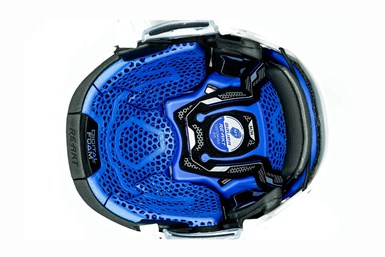Bauer Hockey Uses EOS 3D Printed Digital Foam for Customizing Helmets
The new in-store experience, combined with proprietary 3D printing technology, opens the door for personalized hockey products.
Bauer Hockey and 3D printing provider EOS have collaborated to incorporate additive manufacturing (AM) into Bauer’s MyBauer custom equipment program. Ice hockey helmets have been evolving for more than 50 years, and now 3D printing technologies are changing both product development and the consumer experience in ways never before possible.
“Whether elite athletes or pond hockey players, no two heads are alike,” says Mathieu Dejardins, senior brand manager of protective equipment at Bauer Hockey. “Bauer has now jumped in headlong into ‘mass customization.’ Through our work with EOS and other partners, we are evolving MyBauer custom hockey equipment program to now include helmet inserts specific to the individual, but able to be produced at scale. While Digital Foam is still relatively new, it keeps us out-front of product innovation while also bypassing other engineering and manufacturing limitations.”
Bauer had investigated how to leverage and incorporate AM into its business by benchmarking all industrial 3D printing OEMs, and determined that EOS and its patented Digital Foam material approach to printing polymers gave them a distinct advantage. With MyBauer, personalized (individualized) products now reach the mass market for ice hockey, and with the third generation of the REAKT helmet, gone are the days of simply small, medium or large offerings.
The process for 3D Printing Digital Foam helmet inserts includes scanning a player’s head and creating a digital file. Then, then using selective laser sintering (SLS), a helmet insert —— created to fit perfectly to its wearer — is 3D printed in Digital Foam. The printing involves a complex, varying lattice that is both personalized for the wearer for improved comfort, but also lighter weight (at 580 grams) and with greater breathability. Once printed, the helmet inserts are colored, finished and redied for final assembly. The production of the REAKT helmet is vertically integrated and is produced in Canada at Bauer’s Quebec facility.
“The innovation at Bauer is amazing, and the sports equipment industry is really starting to think about how to leverage 3D printing, and the role Digital Foam can play in all manner of protective gear, and products designed for comfort,” says Jon Walker, Digital Foam expert at EOS North America. “We are proud of the role Digital Foam has played in the production of Bauer’s premium helmet offering. Conventional manufacturing is not going to be supplanted by 3D printing, but rather augmented by it and this project is a stellar example.”
- Watch this episode of The Cool Parts Show to see how scanning feet for their geometry and pressure enables Aetrex and EOS to manufacture insoles that are unique to individual wearers.
- Read how EOS joined forces with General Lattice, DyeMansion and Wilson Sporting Goods to create the industry’s first 3D printed airless basketball prototype.
- Read about EOS’ plans to create a Southern California Additive Manufacturing Innovation Center to support its growing aerospace, space, medical and consumer goods markets.
Related Content
-
3D Systems, Klarity Partner to Expand Access to Patient-Matched Radiotherapy Innovations
Klarity has added 3D Systems’ VSP Bolus to its radiotherapy solutions, enabling radiotherapy clinics in the U.S. and Canada to embrace 3D printing technology without investing in costly, time-consuming software.
-
8 Cool Parts From Formnext 2023: The Cool Parts Show #65
New additive manufacturing technologies on display at Formnext were in many cases producing notable end-use components. Here are some of the coolest parts we found at this year’s show.
-
Admatec’s Larger Integrated Binding/Sintering Furnace for Ceramic 3D Printing
Company scales up for more efficient mass customization and serial ceramics 3D printing production lines.
















